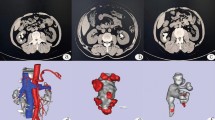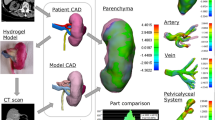Abstract
This study assesses the feasibility and effectiveness of using a three-dimensional (3D) printing model for preoperative planning in the treatment of full staghorn stones, specifically in the selection of the most optimal calyx for puncture. Twelve patients were enrolled in this trial. A preoperative CT taken in prone position was performed on each of the patients. 3D models were reconstructed using digital imaging and 3D printers. Three identical models were printed for each patient. Three puncture sites from the upper-, middle-, and lower-pole calyces of the kidney models were selected for simulation of percutaneous nephrolithotomy. The stone-free rates were recorded after each of the simulations. The puncture site that yielded the maximum SFR was translated to the patient for the actual procedure. CT was performed postoperatively on both patients and simulation models. The SFR of patients and simulation models was compared. Correlation analysis and consistency analysis suggested that there was a high degree of consistency between patients and 3D-printed models. The Pearson product-moment correlation coefficient r for the postoperative stone volume of the patients (PoSVP) and postoperative stone volume of the models (PoSVM) was 0.972 (P < 0.001, 95% CI = 0.900–0.992). The Bland–Altman plot of PoSVP to PoSVM showed an icon of 95% consistency 205.8(− 725.5 ~ 1137.1), and 100% of the points were within the 95% limits of agreement. 3D-printed models can potentially be used for preoperative planning in the treatment of full staghorn stones, especially in the selection of the most optimal calyx for puncture.





Similar content being viewed by others
References
Preminger GM, Assimos DG, Lingeman JE, Nakada SY, Pearle MS, Jr Wolf JS (2005) Chapter 1: AUA guideline on management of staghorn calculi: diagnosis and treatment recommendations. J Urol 173(6):1991–2000
Mishra S, Sabnis RB, Desai MR (2012) Percutaneous nephrolithotomy monotherapy for staghorn: paradigm shift for ‘staghorn morphometry’ based clinical classification. Curr Opin Urol 22(2):148–153
Rassweiler JJ, Renner C, Eisenberger F (2000) The management of complex renal stones. BJU Int 86(8):919–928
Aminsharifi A, Irani D, Masoumi M, Goshtasbi B, Aminsharifi A, Mohamadian R (2016) The management of large staghorn renal stones by percutaneous versus laparoscopic versus open nephrolithotomy: a comparative analysis of clinical efficacy and functional outcome. Urolithiasis 44(6):551–557
Ganpule AP, Desai M (2008) Management of the staghorn calculus: multiple-tract versus single-tract percutaneous nephrolithotomy. Curr Opin Urol 18(2):220–223
Mishra S, Sabnis RB, Desai M (2012) Staghorn morphometry: a new tool for clinical classification and prediction model for percutaneous nephrolithotomy monotherapy. J Endourol 26(1):6–14
Youssef RF, Spradling K, Yoon R, Dolan B, Chamberlin J, Okhunov Z, Clayman R, Landman J (2015) Applications of three-dimensional printing technology in urological practice. BJU Int 116(5):697–702
Soliman Y, Feibus AH, Baum N (2015) 3D printing and its urologic applications. Rev Urol 17(1):20–24
Chanprasopon P, Kongchareonsombat W, Leenanupunth C, Kijvikai K, Viseshsindh W (2013) The best calyceal tract approach for treating renal stones with percutaneous nephrolithotomy. J Med Assoc Thail 96(5):575–579
Blum KA, Parkhomenko E (2018) A contemporary lower pole approach for complete staghorn calculi: outcomes and efficacy. World J Urol 36(9):1461–1467
Gupta M, Desai M, De Lisa A, Turna B, Rioja J, Walfridsson H, D’Addessi A, Wong C, Rosette, On Behalf Of The Croes Pcnl Study Group J (2011) The clinical research office of the endourological society percutaneous nephrolithotomy global study: staghorn versus nonstaghorn stones. World J Urol 25(8):1263–1268
Kukreja R, Desai M, Patel S, Bapat S, Desai M (2004) Factors affecting blood loss during percutaneous nephrolithotomy: prospective study. J Endourol 18(8):715–722
Gorbachinsky I, Wood K, Colaco M, Hemal S, Mettu J, Mirzazadeh M, Assimos DG, Gutierrez-Aceves J (2016) Evaluation of renal function after percutaneous nephrolithotomy-does the number of percutaneous access tracts matter? J Urol 196(1):131–136
Thomas K, Smith NC, Hegarty N, Glass JM (2011) The Guy’s stone score–grading the complexity of percutaneous nephrolithotomy procedures. Urology 78(2):277–281
Okhunov Z, Friedlander JI, George AK, Duty BD, Moreira DM, Srinivasan AK, Hillelsohn J, Smith AD, Okeke Z (2013) STONE nephrolithometry: novel surgical classification system for kidney calculi. Urology 81(6):1154–1159
Brehmer M, Beckman MO, Magnusson A (2014) Three-dimensional computed tomography planning improves percutaneous stone surgery. Scand J Urol 48(3):316–323
Wake N, Bjurlin MA, Rostami P, Chandarana H, Huang WC (2018) Three-dimensional printing and augmented reality: enhanced precision for robotic assisted partial nephrectomy. Urology 116:227–228
Ghazi A, Campbell T, Melnyk R, Feng C, Andrusco A, Stone J, Erturk E (2017) Validation of a full-immersion simulation platform for percutaneous nephrolithotomy using three-dimensional printing technology. J Endourol 31(12):1314–1320
Atalay HA, Canat HL, Ulker V, Alkan I, Ozkuvanci U, Altunrende F (2017) Impact of personalized three-dimensional 3D printed pelvicalyceal system models on patient information in percutaneous nephrolithotripsy surgery: a pilot study. Int Braz J Urol 43(3):470–475
Funding
This research was funded by Science and Technology Planning Project of Guangdong Province, Grant no [2017B030314108] and Natural Science Foundation of Guangdong Province, Grant no [2018A030313087].
Author information
Authors and Affiliations
Corresponding author
Ethics declarations
Conflicts of interest
The authors declare that they have no conflict of interest.
Additional information
Publisher's Note
Springer Nature remains neutral with regard to jurisdictional claims in published maps and institutional affiliations.
Rights and permissions
About this article
Cite this article
Xu, Y., Yuan, Y., Cai, Y. et al. Use 3D printing technology to enhance stone free rate in single tract percutaneous nephrolithotomy for the treatment of staghorn stones. Urolithiasis 48, 509–516 (2020). https://doi.org/10.1007/s00240-019-01164-8
Received:
Accepted:
Published:
Issue Date:
DOI: https://doi.org/10.1007/s00240-019-01164-8




